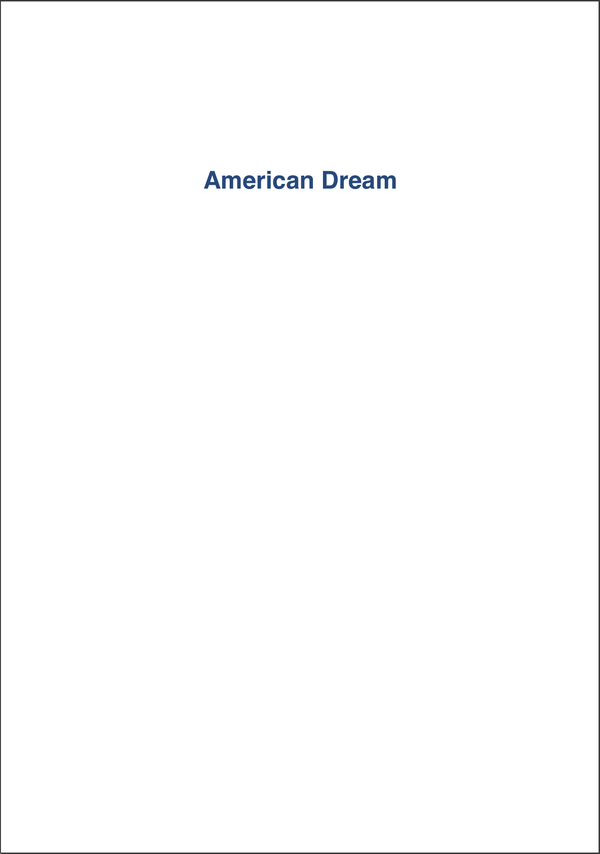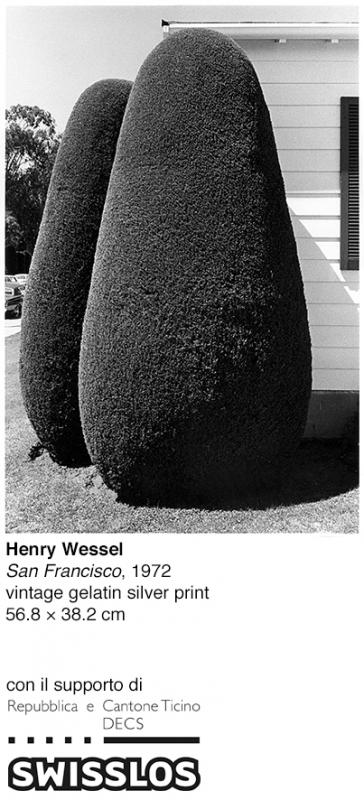American Dream
07.10.2017 - 10.12.2017
"American Dream" was used for the first time by American historian James Truslow Adams in his book The Epic of America, published in 1931. In the middle of the so-called Great Depression he used this expression to describe the complex beliefs, religious promises, and the political and social expectations of the American people.
The exhibition shows suggestive images of important international authors from the private collection of Rosella and Philip Rolla (Robert Adams, Lewis Baltz, Richard Benson, Margaret Bourke-White, William Eggleston, Steve Fitch, Lee Friedlander, Frank Gohlke, Anthony Linck, Ezra Stoller, Hiroshi Sugimoto, Henry Wessel) which represent the socio-economic and cultural development of America from the 1950s to the present.
In the catalog a short text by Christian Marazzi in conversation with Philip Rolla about some personal experiences collected during his time at the University of Santa Clara.
The exhibition American Dream is part of Bi10 Biennale dell'immagine - Borderlines. Città divise/Città plurali.

Lee Friedlander
Cody Wyoming, 2000
gelatin silver print
37.6 x 37.2 cm
American photographer who has focused on the changing landscape of the American West recording there, in over fifty books. His work first came to prominence in the mid-1970s through his book The New West (1974) and his participation in the exhibition New Topographics: Photographs of a Man-Altered Landscape in 1975. He has received two Guggenheim Fellowships, a MacArthur Fellowship, the Deutsche Börse Photography Prize and the Hasselblad Award. He lives with his wife Kerstin in Astoria, Oregon, United States of America.
He studied at the San Francisco Art Institute, and received an MFA from the Claremont Graduate School in 1971. He worked as a freelance photographer in California and taught photography at various institutions. His work has been included in major exhibitions, including New Topographics at the George Eastman House in 1975. He produced photographs in series focused on a particular theme or geographic area and usually published them in book form.
Richard Mead Atwater Benson was an American photographer, printer, and educator who used photographic processing techniques of the past and present. He is perhaps best known for his innovations in photographic offset printing techniques and, later, ink-jet printing. He was awarded two Guggenheim Fellowships and a MacArthur Fellowship. His work is held in the collections of Los Angeles County Museum of Art, Metropolitan Museum of Art, San Francisco Museum of Modern Art and Whitney Museum of American Art.
She began taking industrial photographs when she was twenty and had an incredible will power, obsession for perfection and a great desire to gauge herself not only with photography but also with subjects which were unusual for women: the industrial world, current affairs, reportage on America and on things contemporary. In 1929, she came to a professional crossroads, and went to New York to work on the launching of Fortune magazine and, in 1935, of Life magazine. She was the first Western photographer to be allowed inside the USSR to take photos. She became the first female war correspondent of the Second World War and in 1941 became the official photographer of the U.S. Army Air Force.
After graduating from the University of California at Berkeley in 1971 with a bachelor’s degree in anthropology, and while teaching photography at the ASUC Studio on the Berkeley campus, he began work on a project photographing the vernacular roadside of the American highway. He received two National Endowment for the Arts Fellowships to aid in the completion of this project, one in 1973 and the second in 1975. Eventually, the photographs were published in the monograph, Diesels and Dinosaurs, in 1976.
Lee Friedlander began photographing the American social landscape in 1948. With an ability to organize a vast amount of visual information in dynamic compositions, Friedlander has made humorous and poignant images among the chaos of city life, dense natural landscape, and countless other subjects. Friedlander is also recognized for a group of self-portraits he began in the 1960s, reproduced in Self Portrait, an exploration that he turned to again in the late 1990s,.
Frank Gohlke is an American landscape photographer. He has been awarded two Guggenheim fellowships, two fellowships from the National Endowment for the Arts, and a Fulbright Scholar Grant. Gohlke was one of ten photographers selected to be part of "New Topographics: Photographs of a Man-Altered Landscape," the landmark 1975 exhibition at the International Museum of Photography at George Eastman House.
He was a Life magazine photographer from 1945 to 1954. The two great loves of his life were flying and photography. He left Life magazine to become a freelance photographer specializing mainly in aircraft and industrial photography.
Photojournalist best known for his documentary conflict photographs, being a White House photographer, a fashion photographer, and a film director.
He has received many awards including the Robert Capa Gold Medal, the Olivier Rebbot Award, and the Infinity Award for photojournalism from the International Center of Photography. Morris is a founding member of the photojournalist agency VII in New York. Lives in Vancouver, Canada.
Putnam and Carlton Valentine were commercial photographers in Los Angeles from about 1895 into the early 20th century. There were two Putnams, John R. and his son Arion.
Ezra Stoller was born in Chicago in 1915, grew up in New York and studied architecture at NYU. As a student, he began photographing buildings, models and sculpture; in 1938, he graduated with a BFA in Industrial Design. In 1940-1941, Stoller worked with the photographer Paul Strand in the Office of Emergency Management; he was drafted in 1942 and was a photographer at the Army Signal Corps Photo Center. After World War II, Stoller continued his career as an architectural photographer and also focused on industrial and scientific commissions.
Hiroshi Sugimoto is a Japanese photographer and artist. One of the most important exponents of contemporary photography, representative of serial photography inspired by minimalist and conceptual art in the tradition of Eastern sobriety and simplicity. Known for his rigor in reproducing meticulous black-and-white prints that he makes with a careful and sophisticated technique by handcrafting photographic emulsions that he exhibits at different and exclusive times and methods. He lives between Tokyo and New York.
His body of work has continually focused on the American landscape. He began photographing at the age of 14, when he joined the Carteret Camera Club. He briefly studied commercial photography at Newark Vocational and Technical High School. At sixteen he left high school to work as a darkroom assistant for a Newark portrait studio. A year later he enlisted in the U.S. Navy, serving as a photographer's mate. In 1959, a published image he made of an explosion aboard the USS Wasp caught the eye of photographer Edward Steichen, who as director of photography at the Museum of Modern Art, acquired the print for the museum’s collection. Especially well known as a master printer, Tice printed for artists like Edward Steichen as well as printing the portfolios of such artists as Frederick H. Evans and Edward Weston.
Wessel came to photography almost accidentally during his years at Pennsylvania State University, but he was immediately hooked. He began to photograph seriously in 1967, inspired by the work of Wright Morris, Robert Frank, and Garry Winogrand, and in 1971 he was awarded a Guggenheim grant to document the landscape that flanks the American highway system, a once-natural terrain profoundly transformed by human presence. In the 1970s, Wessel became part of a generation of artists who challenged and expanded the categories of landscape and documentary photography, foregoing traditional views of pristine nature in favor of straightforward and personal depictions of the built environment.

Pages: 48 Softcover
Illustrations: 33 four-color print
Language: Italian/English
Edition: Fondazione Rolla, 2017



























